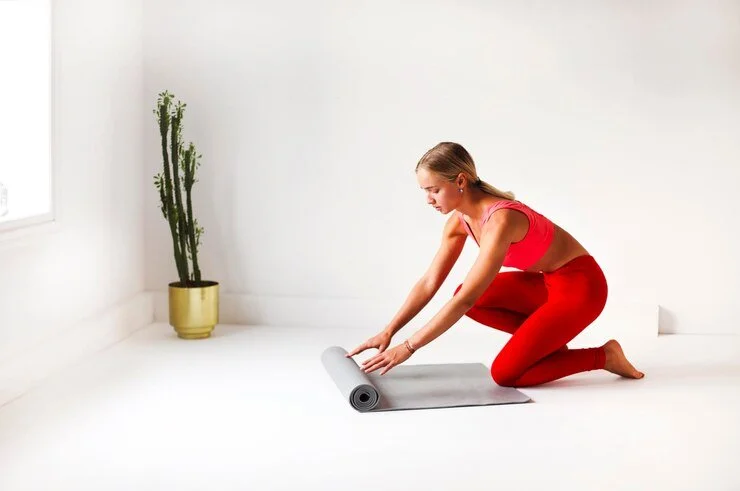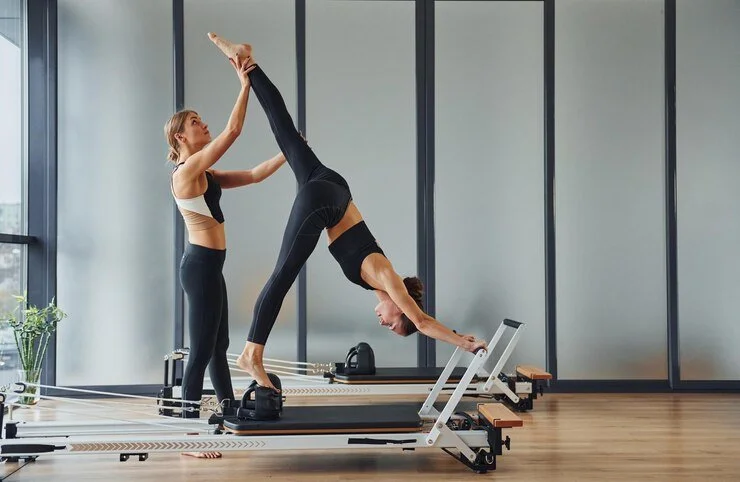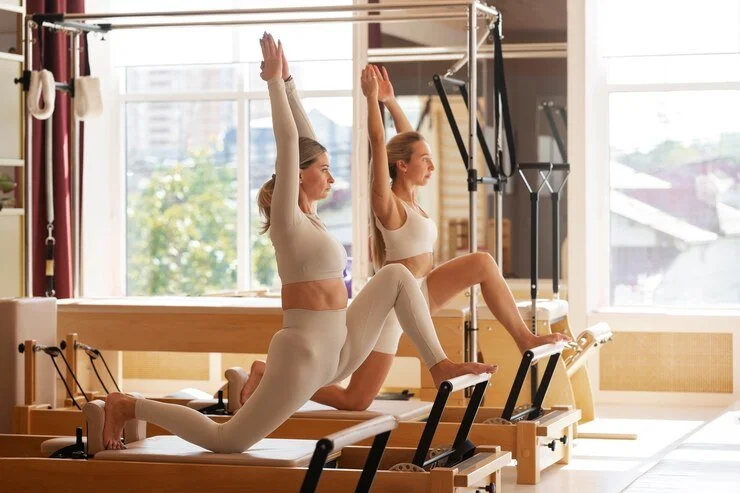Mat Pilates vs. Reformer Pilates: Which Is Right for You?
Author
NATHAN BETHELL
I’m Nathan Bethell, the founder of ReformerPilates.com and someone at the very start of my own Reformer Pilates journey. Through my blog, I’ll be sharing my experiences, insights, and reflections as I progress—celebrating the wins, embracing the challenges, and discovering how Reformer Pilates can enhance both body and mind.
join us
Start your
sessions today
The key difference between the two forms of exercise is that mat Pilates uses body weight for resistance and is accessible anywhere. It focuses on core strength and flexibility. Reformer Pilates, on the other hand, utilises a reformer bed with adjustable springs and straps, offering greater versatility, intensity, and support. This makes it ideal for those seeking a full-body workout or injury rehabilitation.
Invented by Joseph Pilates in the 1920s, Pilates focuses on controlled movements to stretch, strengthen, and balance the body. However, the mat Pilates vs. reformer Pilates debate has created a world where several fitness enthusiasts are torn between the two workouts. Despite each offering unique benefits and challenges, the discourse on which is better lingers.
In this comparison guide, you’ll discover the key differences between these two popular Pilates variations. This knowledge will help you make an informed decision based on your fitness goals, budget, and personal preferences. Let’s begin by exploring the basic differences between each type of Pilates.
Table of Contents
2. Exercise Variety and Intensity
3. Suitability for Different Fitness Levels
1. Improved Posture and Flexibility
2. Enhanced Balance and Coordination
3. Pain Reduction and Core Strengthening
4. Mental Well-Being and Stress Relief
The Advantages of Reformer Pilates
1. Full-Body Workout and Core Strengthening
2. Enhanced Flexibility and Balance
3. Injury Prevention and Rehabilitation
Who Should Choose Mat Pilates?
1. Low-Impact Workout Enthusiasts
2. Those Who Need to Build a Strong Foundation
3. Those Who Prioritise Accessibility and Convenience
Who Should Choose Reformer Pilates?
1. Strength and Stability Seekers
2. Full-Body Workout Enthusiasts
3. Low-Impact, High-Intensity Seekers
What is the difference between mat Pilates and reformer Pilates?
Which is better for beginners: mat or reformer Pilates?
Is mat Pilates harder than reformer?
Is mat Pilates as good as reformer?
The main difference between mat Pilates and reformer Pilates lies in the equipment used. Mat Pilates relies solely on your body weight for resistance, requiring no equipment beyond a mat. In contrast, reformer Pilates uses a specialised machine with adjustable springs, straps, and a sliding carriage to provide resistance and support.
While mat Pilates is more accessible and budget-friendly, reformer Pilates offers greater versatility, customisation, and a full-body workout tailored to diverse fitness levels.
According to the Reddit user “NotTotallyHere,” a Pilates studio staff:
“The Reformer assists or challenges you, sometimes at the same time. The Mat is you versus gravity, and gravity always wins, but you can do it anywhere. I do have clients that have definite preferences—some like one, and some like the other. We view a good workout as one where you feel tired and worked but without muscle soreness limiting your other activities.”
The following reformer vs. mat Pilates table summarises the core distinctions between these two popular Pilates methods.
| Criteria | Mat Pilates | Reformer Pilates |
|---|---|---|
| Equipment Used | Requires only a mat; relies on body weight for resistance. | Uses a specialised machine (reformer) with springs, straps, and a sliding carriage. |
| Exercise Variety | Offers foundational exercises; limited to bodyweight movements. | Provides a wider range of exercises and adjustable resistance for targeted muscle groups. |
| Intensity Level | Generally lower intensity; focuses on control and core engagement. | Allows for greater intensity and customisation with adjustable resistance levels. |
| Suitability for Beginners | An ideal starting point to learn basic principles and proper form. | Suitable for beginners but often requires guidance due to the complexity of the machine. |
| Accessibility | Highly accessible; can be practised anywhere with minimal setup. | Requires access to a reformer machine that’s often available in studios or gyms. |
| Cost | Affordable; requires minimal investment for equipment or classes. | Typically more expensive due to equipment costs and studio fees. |
| Flexibility and Balance | Improves balance and coordination through controlled body movements. | Enhances flexibility and balance with a wider range of motion supported by the reformer. |
| Injury Support | Offers basic support for those with minor injuries or limitations. | Provides excellent support for injury rehabilitation and prevents further strain. |
| Workout Focus | Emphasises core strength, flexibility, and body awareness. | Delivers a full-body workout, combining strength, flexibility, and muscle toning. |
| Portability | Easy to carry out at home, outdoors, or in a studio. | Requires specialised equipment and dedicated space. |
| Who It’s Best For | Low-impact enthusiasts, beginners, or those seeking convenience. | Strength and stability seekers, individuals recovering from injuries, or fitness enthusiasts seeking a high-intensity, low-impact regimen. |
Here’s a more detailed look into how these two Pilates methods differ:
1. Equipment and Resistance
The primary distinction in the mat Pilates vs. reformer Pilates comparison lies in the equipment used and the source of resistance. Mat Pilates relies on bodyweight exercises, which utilise only a mat for support. In contrast, reformer Pilates relies on a specialised machine with springs, straps, and a sliding carriage to provide resistance and support.
2. Exercise Variety and Intensity
While mat Pilates offers a solid foundation for beginners, reformer Pilates allows for a wider range of exercises and intensity levels. The reformer’s adjustable springs and pulleys enable more advanced movements, which makes it possible to target specific muscle groups with greater precision. This versatility makes reformer Pilates particularly effective for those seeking a more challenging workout.
3. Suitability for Different Fitness Levels
For those new to Pilates, mat exercises provide an excellent starting point to learn proper form and build core strength. However, reformer Pilates offers better support and guidance, making it suitable for beginners, those with limited mobility and those recovering from injuries. The reformer’s design helps maintain proper alignment, reducing the risk of injury while allowing for safer, modified movements.
Despite the ongoing mat vs. reformer Pilates debate, both methods are proven to offer unique benefits. Whether a Pilates reformer or mat is the better choice depends on your individual fitness goals and preferences. Our analysis of the distinct benefits of each type of Pilates will provide you with more information to guide your decision.
The Benefits of Mat Pilates
Mat Pilates exercise offers the following four core benefits:
Improved posture and flexibility
Enhanced balance and coordination
Pain reduction and core strengthening
Mental well-being and stress relief
1. Improved Posture and Flexibility
You’re probably wondering: Does mat Pilates work for those seeking increased flexibility? The short answer is yes.
Mat Pilates is a low-impact exercise that can significantly improve your posture and flexibility. By focusing on core strength and proper alignment, mat Pilates helps strengthen the deep muscles around your spine, leading to better posture in daily life. Regular practice can increase your range of motion, with studies showing significant improvements in hamstring flexibility after consistent mat Pilates sessions.
2. Enhanced Balance and Coordination
Comparisons of reformer Pilates vs Pilates on mats have shown that the latter excels at improving balance and coordination. The controlled movements and focus on body awareness help you develop a stronger mind-body connection. This improved proprioception can translate to better performance in other physical activities and reduced risk of falls.
3. Pain Reduction and Core Strengthening
A common question often asked is, “Is mat Pilates effective for pain management?” and the answer is yes. Mat Pilates can help reduce back pain by strengthening the core muscles that support your spine. The emphasis on proper form and alignment during exercises helps correct imbalances that may be causing discomfort. Additionally, the core-centric nature of mat Pilates builds overall physical strength, particularly in your abdominal and back muscles.
4. Mental Well-Being and Stress Relief
When comparing Pilates reformer or mat variants, don’t overlook the mental benefits of the latter. The focus on breathwork and mindful movement can reduce stress levels and improve overall mental well-being. This mind-body connection fostered by mat Pilates can lead to improved mood, reduced anxiety, and better sleep quality.
Mat Pilates has various perks, ranging from enhanced balance to stress relief. As you explore the floor Pilates vs. reformers argument, remember that each appeals to a different group. To provide you with a dual perspective for a well-rounded decision, we’ll also look at how reformer Pilates benefits you.
The Advantages of Reformer Pilates
Reformer Pilates offers the following advantages:
Full-body workout and core strengthening
Enhanced flexibility and balance
Injury prevention and rehabilitation
Customisable intensity
1. Full-Body Workout and Core Strengthening
When doing a mat Pilates vs. reformer Pilates comparison, you’ll find that reformer Pilates offers a more comprehensive full-body workout. The specialised machine, with its system of springs and pulleys, provides adjustable resistance, allowing you to target major muscle groups while simultaneously developing core strength. This unique approach helps you achieve a toned physique and a strong, stable core.
2. Enhanced Flexibility and Balance
The reformer Pilates machine’s design allows for a wider range of motion, which encourages increased flexibility and balance. As you get used to the reformer Pilates method of exercise, you’ll notice improved mobility and a deeper mind-body connection.
3. Injury Prevention and Rehabilitation
One of the key advantages of reformer Pilates is its ability to prevent injuries and aid in rehabilitation. The reformer machine can accommodate most rehabilitation programs, making it an excellent choice for those with joint or back pain. By focusing on proper form and alignment, reformer Pilates helps correct muscle imbalances and strengthens supportive muscles, thereby reducing your risk of future injuries.
4. Customisable Intensity
One of the top perks of reformer Pilates is the ability to adapt it to various intensity levels. Whether you’re a beginner or an advanced practitioner, the machine’s resistance can be modified to suit your needs, ensuring a challenging yet low-impact workout every time.
In summary, both mat and reformer offer their unique benefits. Hence, making a choice will depend on your experience and exercise goal. To further guide you in making the right decision, we’ll go on to discuss the different groups that each type of Pilate is best suited for.
Who Should Choose Mat Pilates?
The following group of enthusiasts and Pilate practitioners will appreciate a mat class:
Low-impact workout enthusiasts
Those who need to build a strong foundation
Those who prioritise accessibility and convenience
1. Low-Impact Workout Enthusiasts
If you’re looking for a gentle yet effective workout, mat Pilates might be your perfect match. This form of Pilates is particularly suitable for those seeking a low-impact exercise that focuses on using body weight resistance. Mat Pilates is an ideal choice for improving core strength, flexibility, and balance without the need for any equipment.
2. Those Who Need to Build a Strong Foundation
Mat Pilates provides an excellent foundation for learning to control your muscles. By signing up for an advanced mat class, you’ll develop a deep understanding of proper form and technique, which is crucial for any Pilates practice. So, in our mat Pilates vs. reformer Pilates comparison, the former makes an excellent starting point for beginners or those new to the Pilates method.
3. Those Who Prioritise Accessibility and Convenience
One of the biggest advantages of mat Pilates is its accessibility. You can practice it anywhere, whether at home, in a park, or at a studio. This convenience makes it easier to maintain a consistent practice, which is key to achieving results. Additionally, mat Pilates classes are often more affordable than a reformer Pilates class, making it a budget-friendly option for those looking to incorporate Pilates into their fitness routine.
While some may find mat Pilates less intense following this floor Pilates vs. reformer comparison, mat work can equally be challenging and effective. It requires you to use your own body weight as resistance, which can lead to significant improvements in strength, flexibility, and body awareness. Let’s equally explore those groups who will appreciate reformer Pilates better.
Who Should Choose Reformer Pilates?
You’ll appreciate the unique benefits of reformer Pilates if you fall into the following categories:
Strength and stability seekers
Full-body workout enthusiasts
Low-impact, high-intensity seekers
1. Strength and Stability Seekers
If you’re looking to supercharge your core strength and stability, reformer Pilates might be your perfect match. The specialised machine used in reformer Pilates provides adjustable resistance, allowing for a more intense workout compared to mat Pilates. This makes it ideal for those aiming to strengthen their midsection and improve overall body control.
2. Full-Body Workout Enthusiasts
Pilates reformer classes are excellent for individuals seeking a comprehensive full-body workout. The reformer’s versatile design allows you to target major muscle groups more effectively than floor Pilates. What’s more, reformer Pilates can more closely mimic a traditional strength training program, helping you work to muscle fatigue and progressively challenge yourself over time.
3. Low-Impact, High-Intensity Seekers
If you’re after a low-impact yet high-intensity exercise regimen, reformer Pilates fits the bill perfectly. It’s particularly beneficial for those looking to enhance flexibility and range of motion without putting excessive stress on their joints.
The reformer’s moving platform requires greater focus and engagement in stabilising muscles and improving body awareness and control. This makes it an excellent choice for individuals recovering from injuries or those wanting to minimise impact while maximising results.
When doing a mat Pilates vs. reformer Pilates analysis to decide on the better option, consider your fitness goals, experience level, and personal preferences. While both offer significant benefits, reformer Pilates provides a unique blend of resistance training and flexibility work that many find irresistible.
The best approach is often to try both and see which one resonates with you most. Join our Reformer Pilates community to keep in touch with like-minded enthusiasts and improve your overall workout experience with expert-led discussions and tutorials.
Frequently Asked Questions
-
Mat Pilates focuses on exercises performed on the floor, utilising body weight for resistance. These bodyweight exercises emphasise core strength and flexibility. Reformer Pilates, on the other hand, uses a specialised machine that provides adjustable resistance through springs, allowing for a wider range of exercises. This equipment-based approach can further enhance strength and flexibility due to its resistance capabilities.
-
Both mat and reformer workouts offer benefits for beginners, but it’s often recommended to start with mat Pilates. It allows newcomers to master basic principles and body awareness without the added complexity of equipment. Reformer Pilates, while offering resistance benefits, can be more advanced and is best approached once foundational skills are established.
-
Mat Pilates can be more challenging as it relies solely on body weight, demanding greater control and core strength. However, reformer Pilates provides unique stretching capabilities and adjustable resistance, facilitating exercises not possible on a mat. Both forms can be demanding in different ways, but they complement each other well in a balanced Pilates practice.
-
Both mat and reformer Pilates workouts are highly effective, with each offering distinct benefits. Studies indicate that both improve functional mobility, balance, core stability, and overall quality of life. The choice between them depends on personal preference and goals, as both contribute significantly to physical well-being and fitness.
Conclusion
The summary of our mat Pilates vs. reformer Pilates analysis is that the right option will depend on your unique fitness goals, budget, and preferences. Both forms offer significant benefits for strength, flexibility, and overall wellness. If you’re just starting out or prefer working out at home, mat Pilates might be your best bet. For those seeking a more challenging workout or needing extra support, reformer Pilates could be the ideal choice.
The most effective exercise is the one you’ll stick with consistently. Whether you choose mat or reformer Pilates, you’re taking a positive step toward improving your health and fitness. Join our community today to engage in discussions with like-minded enthusiasts, studio owners, and instructors.






